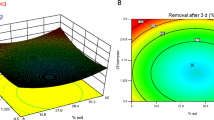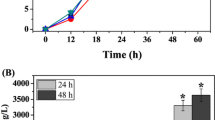Abstract
The bracket-like polypore fungus, Ganoderma australe, was selected for its potential to degrade lindane in liquid agitated sterile cultures. An orthogonal central composite design based on response surface methodology was used to find the optimum biodegradation and biosorption conditions of this pesticide and the growth conditions of the fungus. The factors tested include nitrogen content, initial concentration of lindane, incubation time, and temperature. The optimization parameters investigated were fungus biomass, fungus growth rate, final pH, specific biodegradation, specific biosorption, specific biodegradation rate, biodegraded to biosorbed ratio. The results of the experiments were statistically analyzed and the significance and effect of each factor on responses was assessed. The optimum (maximum) lindane biodegradation (3.11 mg biodegraded lindane per gram biomass) was obtained with nitrogen content of 1.28 g/L, lindane concentration of 7.0 ppm, temperature of 18.0°C, and 5 days of cultivation time.




Similar content being viewed by others
References
Aksu, Z. (2005). Application of biosorption for the removal of organic pollutants, a review. Process Biochemistry, 40, 997–1026. doi:10.1016/j.procbio.2004.04.008.
Alleman, B. C., Logan, B. E., & Gilbertson, R. L. (1992). Toxicity of pentachlorophenol to six species of white rot fungi as a function of chemical dose. Applied and Environmental Microbiology, 58, 4048–4050.
Dritsa, V., & Rigas, F. (2006). Enhanced ligninolytic activity of selected fungi potentially useful in bioremediation applications. WSEAS Transactions on Environment and Development, 9, 1137–1144.
Dritsa, V., Rigas, F., Avramides, E.J., & Hatzianestis, I. (2005). Biodegradation of lindane in liquid cultures by the Polypore fungus Ganoderma australe. Third European Bioremediation Conference, Chania, 4–7 July 2005.
Field, J. A., de Jong, E., Costa, G. F., & de Bont, J. A. M. (1993). Screening for ligninolytic fungi applicable to the biodegradation of xenobiotics. Trends in Biotechnology, 11, 44–49. doi:10.1016/0167-7799(93)90121-O.
Gadd, G. M. (2001). Fungi in bioremediation. Cambridge: Cambridge University Press.
Hattaka, A. (1994). Lignin-modifying enzymes from selected white rot fungi, production and role in lignin degradation. FEMS Microbiology Reviews, 13, 125–135. doi:10.1111/j.1574-6976.1994.tb00039.x.
Laessoe, T. (1998). Mushrooms. London: Dorling Kindersley.
Pokhrel, C. P., & Ohga, C. (2007). Submerged culture conditions for mycelial yield and polysaccharides production by Lyophyllum decastes. Food Chemistry, 105, 641–646. doi:10.1016/j.foodchem.2007.04.033.
Rigas F. (1988) Statistical design of experiments and optimization of industrial processes. Athens: NTUA Publ.
Rigas, F., & Dritsa, V. (2006a). Fungal remediation of contaminated sites. In A. B. Gore (Ed.), Environmental research at the leading edge (pp. 293–331). New York: Nova Science.
Rigas, F., & Dritsa, V. (2006b). Decolourisation of a polymeric dye by selected fungal strains in liquid cultures. Enzyme and Microbial Technology, 39, 120–124. doi:10.1016/j.enzmictec.2005.10.006.
Rigas, F., Marchant, R., Dritsa, V., Kapsanaki-Gotsi, E., Gonou-Zagou, Z., & Avramides, E. J. (2003). Screening of wood rotting fungi potentially useful for the degradation of organic pollutants. Water Air and Soil Pollution Focus, 3, 201–210. doi:10.1023/A:1023994121108.
Rigas, F., Dritsa, V., Marchant, R., Papadopoulou, K., Avramides, E. J., & Hatzianestis, I. (2005). Biodegradation of lindane by Pleurotus ostreatus via central composite design. Environment International, 31, 191–196. doi:10.1016/j.envint.2004.09.024.
Sasek, V., Novothy, C., & Vampola, P. (1998). Screening for efficient organopollutant fungal degraders by decolourisation. Czech Mycology, 50, 303–311.
Singh, B. K., & Kuhad, R. C. (2000). Degradation of insecticide lindane (γ-HCH) by white rot fungus Cyathus bulleri and Phanerochaete sordida. Pest Management Science, 56, 142–146. doi:10.1002/1526-4998(200002)56:2<142::AID-PS104>3.0.CO;2-I.
Yang, F. C., Huang, H. C., & Yang, M. J. (2003). The influence of environmental conditions on the mycelial growth of Antrodia cinnamomea in submerged cultures. Enzyme and Microbial Technology, 33, 395–402. doi:10.1016/S0141-0229(03)00136-4.
Acknowledgements
The project is co-funded by the European Social Fund (75%) and National Resources (25%).
Author information
Authors and Affiliations
Corresponding author
Rights and permissions
About this article
Cite this article
Dritsa, V., Rigas, F., Doulia, D. et al. Optimization of Culture Conditions for the Biodegradation of Lindane by the Polypore Fungus Ganoderma australe . Water Air Soil Pollut 204, 19–27 (2009). https://doi.org/10.1007/s11270-009-0022-z
Received:
Accepted:
Published:
Issue Date:
DOI: https://doi.org/10.1007/s11270-009-0022-z




